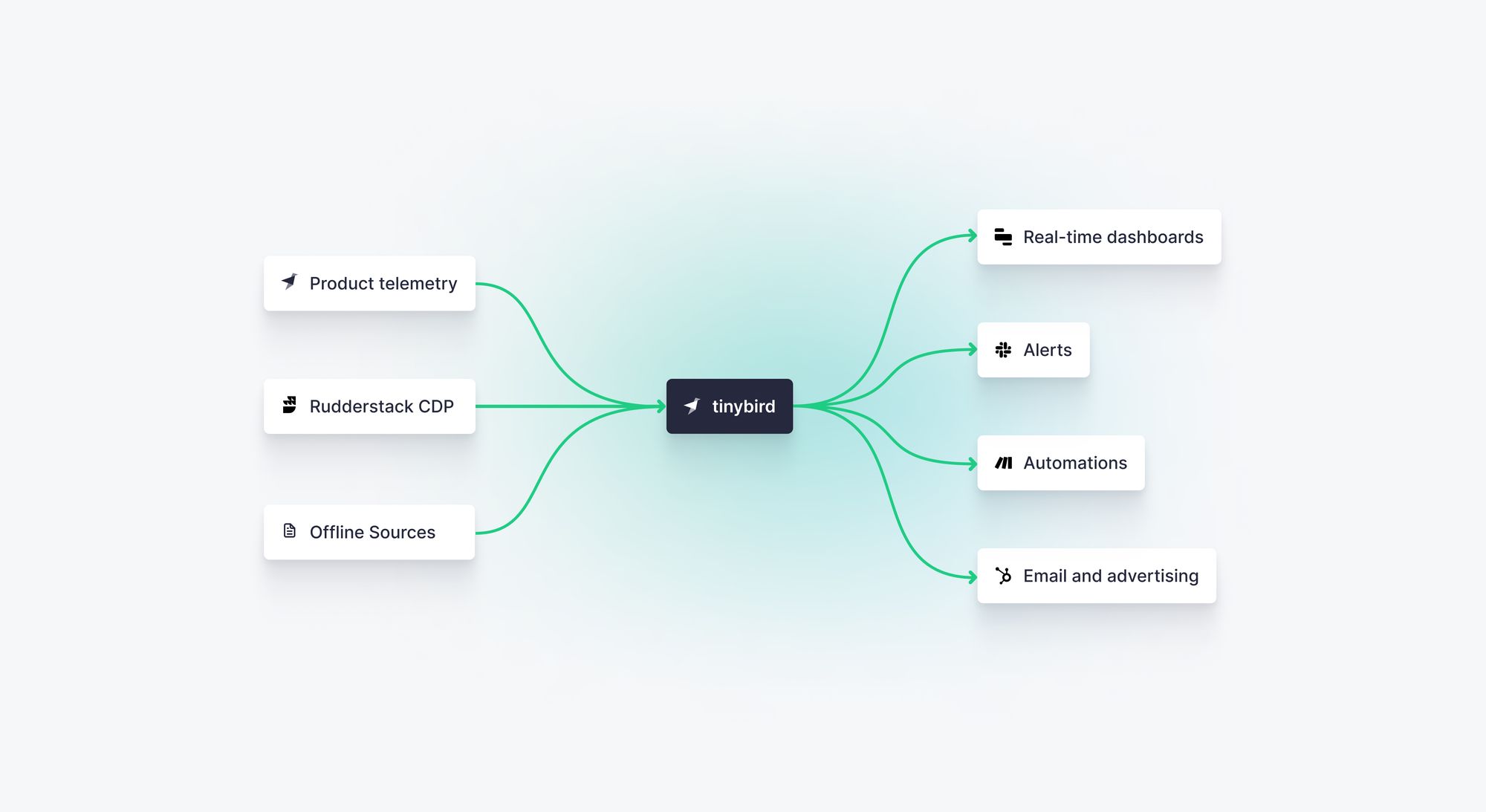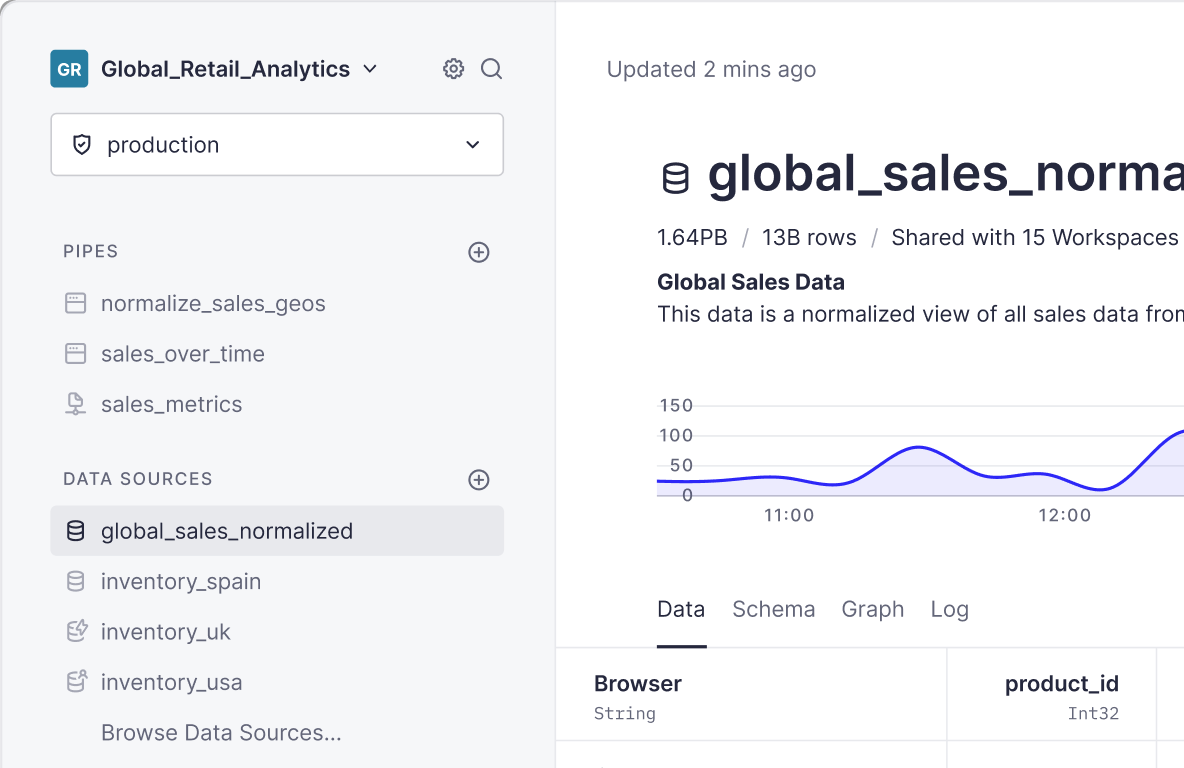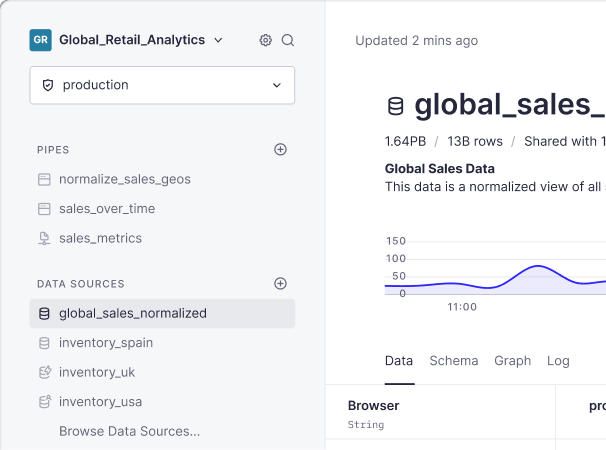The modern business depends on fresh, accurate data. In the old days, you could store data in your data warehouse, run transformations overnight, and have up-to-date dashboards by the next morning. Today, that doesn’t cut it. Data compiled overnight is already stale when your team comes to work in the morning. You need instant access to data as it’s happening.
In addition, it used to be acceptable for humans to spend time digesting the data in a dashboard before taking action. Today, the machines need to talk to one another. Real-time decision-making requires real-time data processing. You need to unify all of your data, whether it’s from streaming or batch sources, write programmatic queries on that data, and then expose those queries to other machines and processes that can act on them automatically.
You can't just rely on dashboards anymore. The machines need to talk to each other.
Data teams used to build dashboards for others to consume. Now they’re building APIs and full-on data products that can be composed to create whatever the business needs: dashboards, personalized landing pages, customized marketing campaigns, and so on.
At Tinybird, we "drink our own champagne" and have fully embraced using Tinybird across our business. We use Tinybird to analyze our CI pipeline, automate customer usage alerting, calculate usage-based billing for our Pro customers, and even replace Google Analytics for privacy and speed.
At Tinybird, we use Tinybird APIs to optimize our business processes across software engineering, customer support, and marketing.
In marketing, we use Tinybird to capture streaming and batch customer usage data, process that data in real time, and use the insights we gain to create actionable marketing tactics that drive our business goals.
Here’s the story of how we use Tinybird to set a new standard for digital marketing.
APIs are the backbone of modern marketing
Today’s marketing stack is comprised of many best-of-breed tools that are stitched together with integrations and APIs. Your CRM is connected to your ads tools, which are connected to your landing pages and your email marketing. Between tag managers and CDPs, you’re never locked into one tool.
Tinybird is a real-time analytics platform that data engineers and developers use to build real-time applications. Our customers build many things, including anomaly detection, website personalization, user-facing analytics, inventory management, and much more.
With Tinybird, data teams can cost-effectively harness fresh, accurate data as it happens. Using Tinybird Connectors, data teams can ingest data from several sources, including Apache Kafka, BigQuery, Snowflake, and even Amazon S3. Data teams then write queries using SQL and version those queries using Git, two technologies teams already know how to use.
And finally, once data teams have built queries, they can push a single button or write a single command-line instruction to expose the queries as low-latency, fully documented, secured APIs.
It’s these APIs that form the foundation of our marketing stack at Tinybird.
Automated marketing through Tinybird APIs
Like most technical products, our customers interact with Tinybird through various touchpoints, including a command-line interface (CLI), our website, and an API. Traditional Customer Data Platforms (CDPs) typically excel at tracking website interactions but fall short when it comes to the multifaceted nature of our product's usage. Already, we use Tinybird to capture and harness all user telemetry across these platforms in real-time.
We use Tinybird to capture and analyze user telemetry data across our CLI, UI, marketing website, and API.
Alison Davey on our data team has built APIs that query our user telemetry data streams and expose the following information:
- The amount of data a customer has ingested in the first 7 days, 30 days, and 90 days
- The number of queries a customer has run in the first 7 days, 30 days, and 90 days
- The amount of data a customer has ingested in the last 7 days, 30 days, and 90 days
- The number of queries a customer has run in the last 7 days, 30 days, and 90 days
Together, these four numbers that paint a very interesting picture of:
- The number of quality sign-ups: How many users have signed up who actually use the product after signup? (As every SaaS marketer knows, many people will sign up for your product and never do anything with it. There’s a ton of insight to be had in understanding why this is the case, but that’s a story for another day)
- The number of retained sign-ups: How many users continue to use the product? (Retention, of course, is the holy grail metric for SaaS marketers)
With Tinybird, we can easily get all of these metrics in SQL. For example, here’s the query Alison wrote to retrieve the amount of data ingested by a customer in the last thirty days:
This SQL gets instantly published as a parameterized API that we can use in our marketing stack to track how each individual customer is using our product.
We standardize our interaction with Tinybird through these APIs. This gives us a few advantages. First, our APIs represent a consistent way to access the data. I’m not running a subtly different query than the sales team and getting inconsistent results. We all use the same APIs to get the same data. Second, our APIs can be versioned and maintained over time (and Tinybird makes this easy using plain ol’ Git.)
Tinybird APIs give the marketing team a unified, consistent view of our data in real time. We're not running subtly different queries that give us inconsistent results across teams.
Now, you might be saying that, sure, most good marketers have access to these dashboards already. Ah, but remember, we have APIs. And with these APIs, we can build beautiful programmatic actions based on real-time customer data.
Integrating Tinybird with Our MarTech Stack
To ensure our marketing technology (MarTech) stack remains powerful and effective, we've integrated Tinybird with our suite of tools, primarily HubSpot, our primary marketing platform. We run the following Python script periodically throughout the day to query the APIs that front our telemetry data and synchronize it with HubSpot's contact properties.
We then can query Contacts within HubSpot and create custom Lists based on certain properties. For example, we have a continually updated HubSpot List of all our dormant users: users who once used the product but haven’t used it in the last thirty days. With this dynamically updated list, we can run automated email outreach to reactivate these users.
We use Tinybird to identify dormant users, add them to a Hubspot list, and run email nurture campaigns to bring them back to the product.
Another example is what we internally call “Project Hummingbird” (we love bird names at Tinybird). With Project Hummingbird, we are on the lookout for certain usage patterns that help us identify users who need help and could potentially benefit from a more structured usage agreement.
For example, suppose a customer is rapidly ingesting a massively larger quantity of data than they were previously. This could indicate a bug in their code, a load test, or maybe their business is just taking off like gangbusters.
Shoutout to @tinybirdco for realizing we were consuming data like a black hole and getting their team onboard fast to help us optimize
— Dan Goodman (@Dan_The_Goodman) November 10, 2023
I know it's a churn-prevention response but still it's really great for customers XD
Most of the time, our customers are just humming along, but now and then, we can head off a potentially costly bug that could spike their storage costs. Or, if we detect they’re doing a load test, we can reasonably ascertain they are about to go into production and can be sure we understand their usage expectations so we can provision enough resources on our end (some of our customers are ingesting and processing petabytes of data every day).
We also use Tinybird to generate alerts on spikes in usage so that we can proactively reach out to customers and help them avoid a surprise bill.
In the case of Project Hummingbird, real-time data is even more important than detecting dormant users. We automatically trigger a Slack notification for the company to see and an email to the customer’s representative on our Customer Success team.
Acting in real-time can significantly improve the customer support experience. Our customer FanDuel also uses Tinybird in this way, identifying VIP customers who could benefit from an enhanced support experience.
Many companies could write these kinds of triggers themselves, but not as quickly as they can with Tinybird.
Beyond email: A/B testing and personalization
We've extended our usage of real-time data to other areas such as A/B testing various website features and personalizing content for our users. This data-driven approach ensures that we're not just guessing what might work — we're applying insights gleaned from actual user behavior to influence our tactics.
For example, we are building out the ability to tailor our post-signup email nurture based on real-time insight into which web pages customers have seen on our website and docs, the frequency and amount of data they are ingesting, and other signals we derive from our product telemetry.
We even use Tinybird to personalize email campaigns to customers based on how they've interacted with our website, product, and campaigns, combining data from many different sources to send our customers the most relevant emails for their needs and use case.
With our personalization project, we are combining three different data sources:
- Website activity data from Rudderstack (our CDP, data from which we stream into a Data Source in our Tinybird Workspace)
- The product telemetry data mentioned above that includes customer ingestion and query usage
- Other data we’ve gathered from events, campaigns, or other "batch data sources".
With Tinybird, we can unify all this data in seconds, write lightning-fast SQL queries over all of the unified data, and expose consistent APIs for the entire company to consume.

Results from real-time marketing at Tinybird
Real-time marketing has massively improved our team's performance in 2023. For the year, we have...
- Increased the rate of product sign-ups by 400%
- Increased user conversions from free to paid by 300%.
- Increased the rate of quality sign-ups by 200%.
While some of this is just good strategy and hard work, we couldn't have achieved these results without real-time analytics and the automated campaigns they've enabled for us.
Conclusion: Real-time data is now table stakes for marketing
In the digital age, real-time data has become the new currency for marketing. It allows us to understand and respond to customer behavior with unprecedented speed and relevance. By integrating Tinybird into our MarTech stack, we've not only streamlined our marketing efforts but also unlocked new levels of personalization and efficiency.
Interested in trying out Tinybird?
Personally, I recommend that you request a demo with one of our engineers so we can walk you through how we use HubSpot and Tinybird together to build a sophisticated real-time marketing engine.
If you're ready to start building, you can get started for free and use the Web Analytics Starter Kit we've created. It's a great place to start if you want to add telemetry and analytics to your customer touchpoints.
As we continue to innovate and refine our marketing strategies and tactics using real-time data, we're excited to share the lessons we learn along the way. Stay tuned for more insights and detailed breakdowns of our real-time marketing methodologies.

